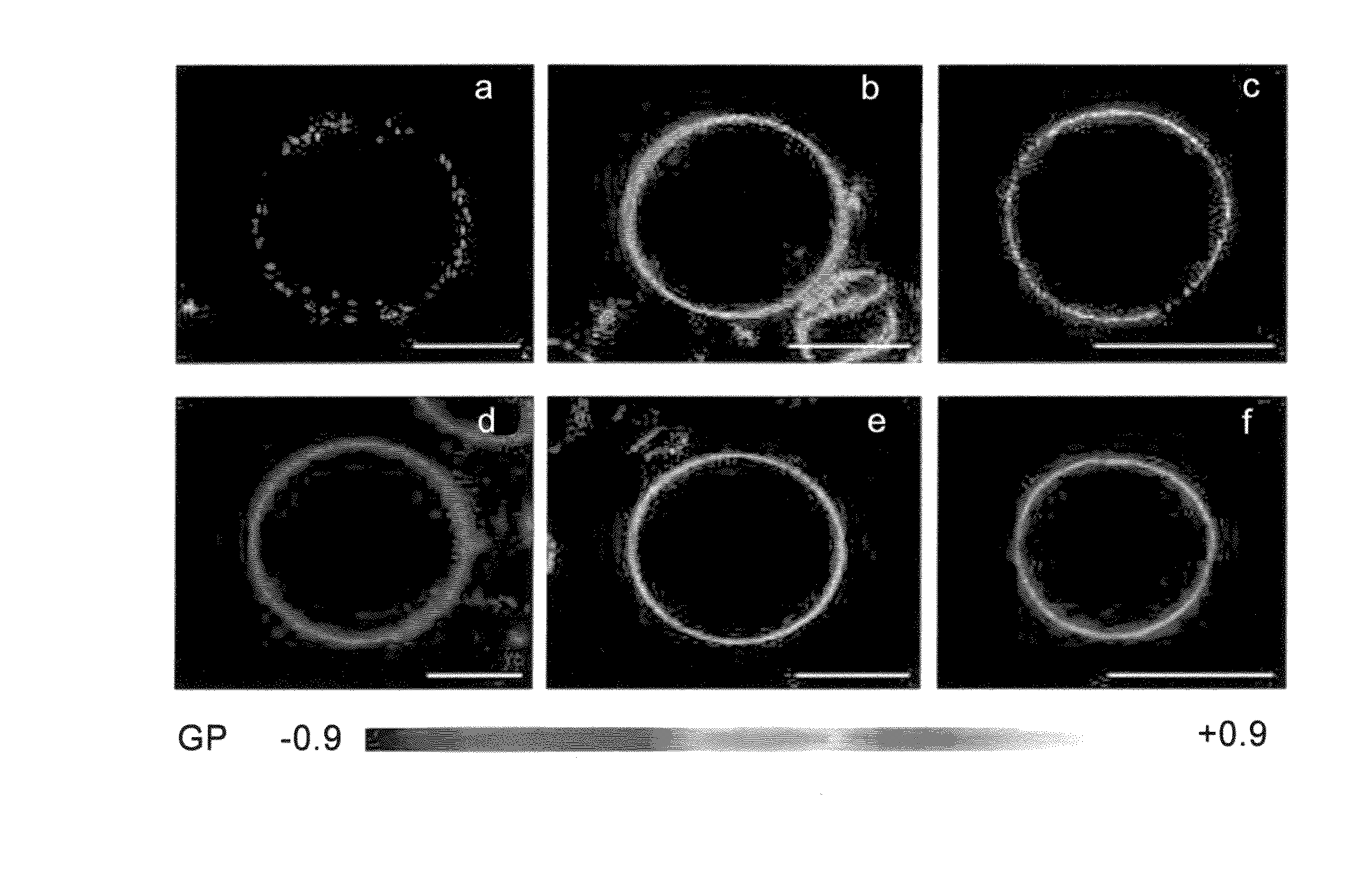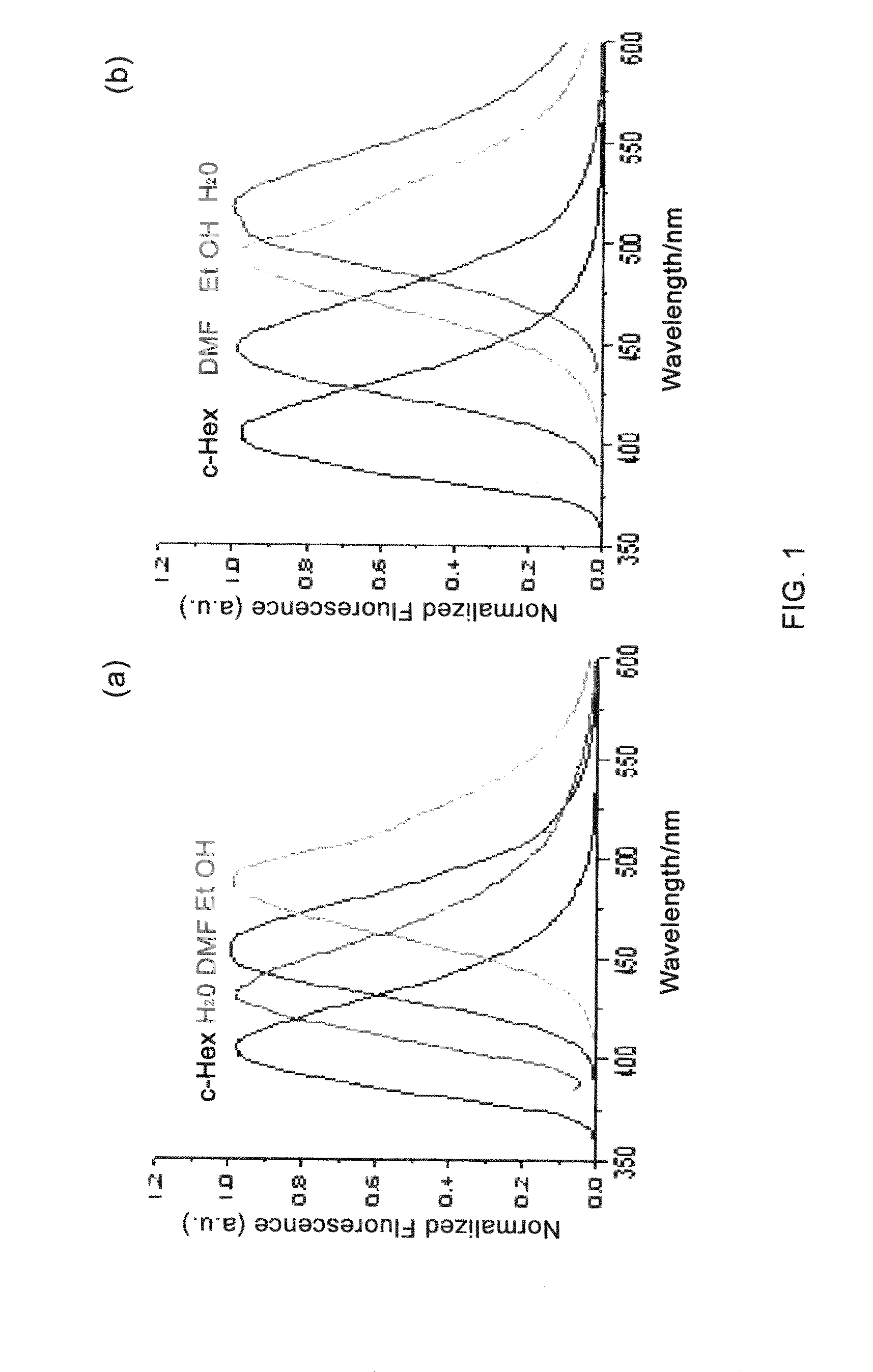Two-photon dyes for real-time imaging of lipid rafts
a technology of lipid rafts and dyes, which is applied in the field of two-photon dyes for real-time imaging of lipid rafts, can solve the problems of inability to observe their real shape using optical microscopes, inability to identify the presence of lipid rafts in living cells, and no lipid raft protein has heretofore remained a dotted pattern. achieve the effect of high intensity
- Summary
- Abstract
- Description
- Claims
- Application Information
AI Technical Summary
Benefits of technology
Problems solved by technology
Method used
Image
Examples
example 1
1-(1): Preparation of 6-dodecanoyl-N-methyl-2-naphthylamine
[0051] MeNH2.HCl (11.0 g, 0.13 mol) was added to a mixture of 2-hydroxy-6-dodecanoylnaphthalene (8.0 g, 25 mmol), Na2S2O5 (12 g, 61 mmol), NaOH (5.2 g, 0.13 mol) and water (100 ml) in a high-pressure tube. The resulting mixture was stirred at 140° C. for 48 hours, followed by filtration to collect a solid. The solid was sufficiently washed with water and recrystallized from CH2Cl2-EtOH to give the title compound (5.6 g, yield: 67%).
[0052]1H-NMR (300 MHz, CDCl3): δ 8.31 (s, 1H), 7.94 (dd, J=9.0, 3.0 Hz, 1H), 7.72 (d, J=9.0 Hz, 1H), 7.64 (d, J=9.0 Hz, 1H), 6.91 (dd, J=9.0, 3.0 Hz, 1H), 6.77 (s, 1H), 3.97 (br s, 1H), 3.03 (t, J=7.5 Hz, 2H), 2.97 (s, 3H), 1.77 (quin, J=7.5 Hz, 2H), 1.26 (m, 16H), 0.88 (t, J=7.5 Hz, 3H);
[0053]13C-NMR (75 MHz, CDCl3): ε 200.59, 149.30,138.23, 130.91, 130.87, 130.08, 126.22, 126.19, 125.05, 118.60, 103.28, 38.64, 32.15, 29.88, 29.86, 29.78, 29.77, 29.76, 20 29.74, 29.58, 25.09, 22.92, 14.36.
1-(...
example 2
Preparation of TPD2
[0057] A mixture of 6-dodecanoyl-N-methyl-2-naphthylamine (3.0 g, 8.8 mmol) prepared in Example 1-(1), BrCH2CH2SO3Na (2.1 g, 10.0 mmol) and proton-sponge (2.2 g, 10.3 mmol) was stirred in DMF (50 ml) under a nitrogen atmosphere at 150° C. for 12 hours. The reaction mixture was extracted with water and dichloromethane, sufficiently washed with brine, and evaporated to remove the solvents. The residue was purified by column chromatography on silica gel using methanol / ethyl acetate (1:5) and recrystallized from chloroform to give TPD2 (1.8 g, yield: 44%).
[0058]1H-NMR (300 MHz, CDCl3): δ 8.42 (s, 1H), 7.90 (d, J=9.0 Hz, 1H), 7.89 (dd, J=9.0, 3.0 Hz, 1H), 7.62 (d, J=9.0 Hz, 1H), 7.20 (dd, J=9.0, 3.0 Hz, 1H), 6.90 (s, 1H), 3.71 (t, J=7.5 Hz, 2H), 3.08 (t, J=7.5 Hz, 2H), 3.01 (s, 3H), 2.68 (t, J=7.5 Hz, 2H), 1.61 (quin, J=7.5 Hz, 2H), 1.26 (m, 16H), 0.83 (t, J=7.5 Hz, 3H).
example 3
Preparation of TPD3
[0059] A mixture of TPD1 (1.6 g, 4.0 mmol) prepared in Example 1-(2), the compound of Formula 7 (1.0 g, 2.0 mmol), DCC (2.4 g, 11.6 mmol) and dimethylaminopyridine (DMAP) (0.24 g, 2.0 mmol) was stirred in chloroform (50 ml) under a nitrogen atmosphere for 96 hours.
[0060] Then, the reaction mixture was evaporated to remove the solvent. Purification by column chromatography on silica gel using chloroform / methanol / water (18:9:1) gave TPD3 (2.2 g, yield: 63%).
[0061]1H-NMR (600 MHz, CDCl3): δ 8.27 (s, 1H), 7.88 (d, J=9.0 Hz, 1H), 7.77 (d, J=9.0 Hz, 1H), 7.62 (d, J=9.0 Hz, 1H), 7.08 (d, J=9.0 Hz, 1H), 6.85 (s, 1H), 5.23 (br m, 1H), 4.39 (d, J=9.5 Hz, 1H), 4.26 (d, J=18 Hz, 1H), 4.18 (d, J=18 Hz, 1H), 4.16 (s, 2H), 4.06 (dd, J=12 Hz, 6.6 Hz, 1H), 3.94 (br s, 2H), 3.57 (br s, 2H), 3.14 (br s, 12H), 2.99 (t, J=7.2 Hz, 2H), 2.08 (t, J=7.8 Hz, 2H), 1.72 (m, 2H), 1.43 (m, 2H), 1.38-1.14 (m, 40H), 0.85 (t, J=7.0 Hz, 6H).
PUM
| Property | Measurement | Unit |
|---|---|---|
| diameter | aaaaa | aaaaa |
| emission wavelengths | aaaaa | aaaaa |
| fluorescence wavelengths | aaaaa | aaaaa |
Abstract
Description
Claims
Application Information
 Login to View More
Login to View More - R&D
- Intellectual Property
- Life Sciences
- Materials
- Tech Scout
- Unparalleled Data Quality
- Higher Quality Content
- 60% Fewer Hallucinations
Browse by: Latest US Patents, China's latest patents, Technical Efficacy Thesaurus, Application Domain, Technology Topic, Popular Technical Reports.
© 2025 PatSnap. All rights reserved.Legal|Privacy policy|Modern Slavery Act Transparency Statement|Sitemap|About US| Contact US: help@patsnap.com



